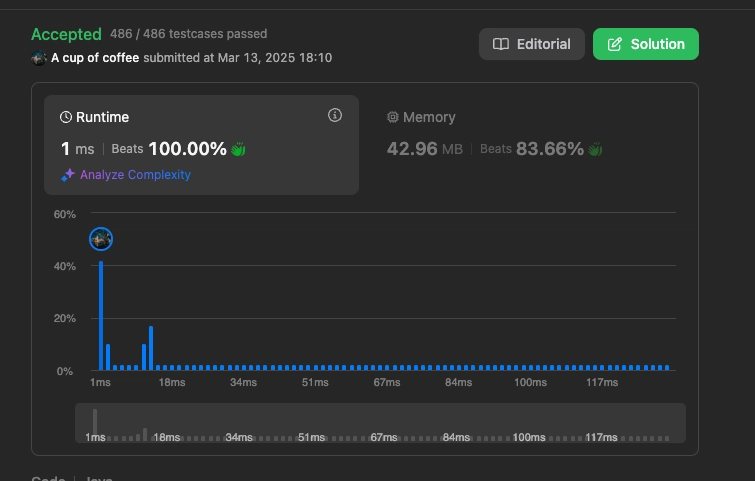Solving the Valid Palindrome Problem in Java
Hey there! If you’re prepping for coding interviews or just love a good string problem, you’ve probably come across the Valid Palindrome challenge. It’s a classic that tests your ability to manipulate strings and think logically. Today, I’ll walk you through solving LeetCode’s “125. Valid Palindrome” problem in Java using a slick two-pointer approach. Let’s dive in! The Problem Here’s the problem straight from LeetCode: 125. Valid Palindrome A phrase is a palindrome if, after converting all uppercase letters into lowercase letters and removing all non-alphanumeric characters, it reads the same forward and backward. Alphanumeric characters include letters and numbers. Given a string s, return true if it is a palindrome, or false otherwise. Examples Input: s = "A man, a plan, a canal: Panama" Output: true Explanation: After cleaning, it becomes "amanaplanacanalpanama", which is a palindrome. Input: s = "race a car" Output: false Explanation: After cleaning, it’s "raceacar", which isn’t a palindrome. Input: s = " " Output: true Explanation: After removing non-alphanumeric characters, it’s an empty string "", which reads the same both ways. Constraints 1

Hey there! If you’re prepping for coding interviews or just love a good string problem, you’ve probably come across the Valid Palindrome challenge. It’s a classic that tests your ability to manipulate strings and think logically. Today, I’ll walk you through solving LeetCode’s “125. Valid Palindrome” problem in Java using a slick two-pointer approach. Let’s dive in!
The Problem
Here’s the problem straight from LeetCode:
125. Valid Palindrome
A phrase is a palindrome if, after converting all uppercase letters into lowercase letters and removing all non-alphanumeric characters, it reads the same forward and backward. Alphanumeric characters include letters and numbers.
Given a strings, returntrueif it is a palindrome, orfalseotherwise.
Examples
Input:
s = "A man, a plan, a canal: Panama"
Output:true
Explanation: After cleaning, it becomes"amanaplanacanalpanama", which is a palindrome.Input:
s = "race a car"
Output:false
Explanation: After cleaning, it’s"raceacar", which isn’t a palindrome.Input:
s = " "
Output:true
Explanation: After removing non-alphanumeric characters, it’s an empty string"", which reads the same both ways.
Constraints
1 <= s.length <= 2 * 10^5-
sconsists of printable ASCII characters.
The goal? Ignore spaces, punctuation, and case, then check if the cleaned string is a palindrome. Sounds fun, right?
My Approach: Two Pointers
There are a few ways to tackle this, but I went with a two-pointer technique because it’s efficient and doesn’t need extra space. The idea is simple: start with one pointer at the beginning (i) and one at the end (j), then move them toward each other. Along the way, skip non-alphanumeric characters and compare the rest, ignoring case. If all pairs match, it’s a palindrome!
Here’s why I like this:
- Time Complexity: O(n) — we only scan the string once.
- Space Complexity: O(1) — no extra arrays or strings needed.
Let’s see it in action.
The Code
Here’s my solution in Java:
class Solution {
public boolean isPalindrome(String s) {
int i = 0;
int j = s.length() - 1;
if (s.isEmpty()) {
return true;
}
while (i < j) {
char left = s.charAt(i);
char right = s.charAt(j);
// Skip if left isn’t alphanumeric
if (!('0' <= left && left <= '9' || 'a' <= left && left <= 'z' || 'A' <= left && left <= 'Z')) {
i++;
continue;
}
// Skip if right isn’t alphanumeric
if (!('0' <= right && right <= '9' || 'a' <= right && right <= 'z' || 'A' <= right && right <= 'Z')) {
j--;
continue;
}
// Compare characters (case-insensitive)
if (left == right || Character.toLowerCase(left) == Character.toLowerCase(right)) {
i++;
j--;
continue;
}
return false;
}
return true;
}
}
How It Works
-
Setup Pointers:
-
istarts at 0,jstarts at the end of the string. - If the string’s empty, return
true(though the constraints guarantee at least 1 character, I added this for clarity).
-
-
Main Loop:
- Grab the characters at
i(left) andj(right). -
Skip Junk: If
leftisn’t a letter or number, incrementi. Same forrightwithj. -
Compare: If both are alphanumeric, check if they match (either directly or after converting to lowercase). If they do, move the pointers inward. If not, return
false. -
Finish: If the loop ends (i.e.,
i >= j), all checks passed, so returntrue.
- Grab the characters at
Walking Through an Example
Let’s run it on "A man, a plan, a canal: Panama":
- Cleaned version (for reference):
"amanaplanacanalpanama". - Step-by-step:
-
i = 0('A'),j = 30('a'):Abecomesa, matchesa. Move toi = 1,j = 29. -
i = 1(' '),j = 29('m'): Skip space,i = 2. -
i = 2('m'),j = 29('m'): Match!i = 3,j = 28. - Fast-forward past spaces, commas, and colons…
- Eventually,
iandjmeet in the middle, and all pairs match.
-
- Result:
true.
Try "race a car" yourself — you’ll see it fails at 'e' vs. 'r'.
Complexity Analysis
- Time Complexity: O(n). We visit each character at most once, even with skips.
- Space Complexity: O(1). Just a couple of pointers and variables—no big data structures.
Refining the Solution
My original code works, but it’s a bit verbose. Here’s a cleaner version using Java’s built-in methods:
class Solution {
public boolean isPalindrome(String s) {
int i = 0;
int j = s.length() - 1;
while (i < j) {
char left = s.charAt(i);
char right = s.charAt(j);
if (!Character.isLetterOrDigit(left)) {
i++;
} else if (!Character.isLetterOrDigit(right)) {
j--;
} else {
if (Character.toLowerCase(left) != Character.toLowerCase(right)) {
return false;
}
i++;
j--;
}
}
return true;
}
}
Changes:
- Swapped manual range checks for
Character.isLetterOrDigit()—more readable! - Simplified the flow by handling the comparison in an
elseblock.
Both versions work, but this one’s easier on the eyes.
Alternative Approaches
You could also solve this by:
-
Cleaning First: Use regex (e.g.,
s.replaceAll("[^a-zA-Z0-9]", "").toLowerCase()) to get a clean string, then check if it’s a palindrome.- Pros: Simpler logic.
- Cons: O(n) space for the new string.
-
Reverse and Compare: Clean the string, reverse it, and check equality.
- Cons: Same space issue.
The two-pointer method wins for efficiency in interviews!
Conclusion
And there you have it—a solid solution to the Valid Palindrome problem! We used two pointers to check the string in-place, skipping non-alphanumeric characters and handling case-insensitivity on the fly. It’s fast, lean, and perfect for impressing interviewers.
Try running this code on your own test cases—like "0P" or ".,"—and see how it holds up. Let me know in the comments if you’ve got questions or a cool twist on this problem. Happy coding!











































































































































































![[The AI Show Episode 142]: ChatGPT’s New Image Generator, Studio Ghibli Craze and Backlash, Gemini 2.5, OpenAI Academy, 4o Updates, Vibe Marketing & xAI Acquires X](https://www.marketingaiinstitute.com/hubfs/ep%20142%20cover.png)




























































































































![[DEALS] The Premium Learn to Code Certification Bundle (97% off) & Other Deals Up To 98% Off – Offers End Soon!](https://www.javacodegeeks.com/wp-content/uploads/2012/12/jcg-logo.jpg)


![From drop-out to software architect with Jason Lengstorf [Podcast #167]](https://cdn.hashnode.com/res/hashnode/image/upload/v1743796461357/f3d19cd7-e6f5-4d7c-8bfc-eb974bc8da68.png?#)








































































































.png?#)

































_Christophe_Coat_Alamy.jpg?#)
 (1).webp?#)





































































































![Apple Considers Delaying Smart Home Hub Until 2026 [Gurman]](https://www.iclarified.com/images/news/96946/96946/96946-640.jpg)
![iPhone 17 Pro Won't Feature Two-Toned Back [Gurman]](https://www.iclarified.com/images/news/96944/96944/96944-640.jpg)
![Tariffs Threaten Apple's $999 iPhone Price Point in the U.S. [Gurman]](https://www.iclarified.com/images/news/96943/96943/96943-640.jpg)




































































































































